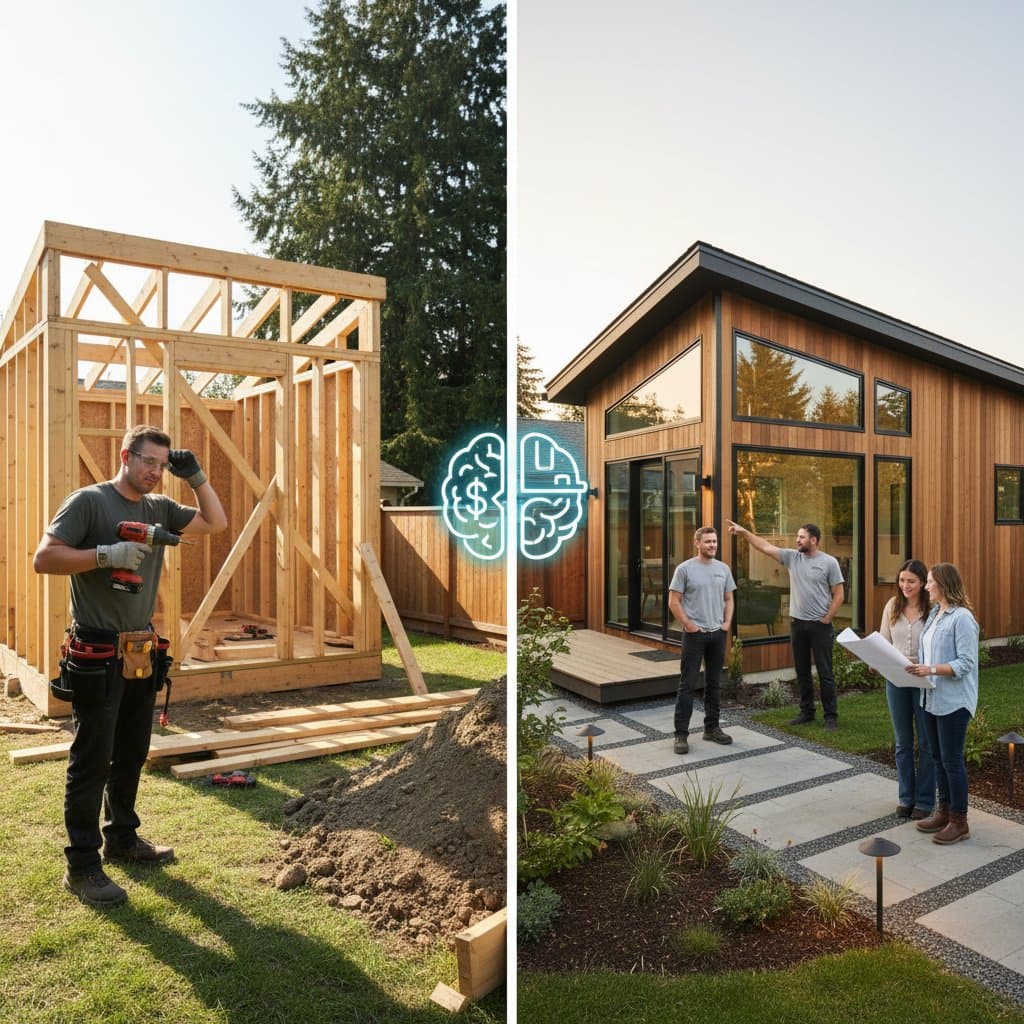DIY ADU Construction Versus Professional Build: Balancing Savings and Risks
Homeowners often consider adding an accessory dwelling unit to create rental income, accommodate guests, or establish a private workspace. Such a project transforms underutilized backyard space into a functional extension of the property. The core decision involves whether to undertake the construction personally or engage qualified contractors.
Each approach yields a completed unit, yet they differ significantly in financial outlay, project duration, and stress levels. A self-directed build may reduce expenses substantially, whereas professional involvement minimizes errors and ensures compliance. This analysis details the implications for budget, schedule, and well-being.
Advantages of DIY Construction: Personal Investment and Reduced Expenses
For those seeking to lower costs, a do-it-yourself ADU project offers substantial appeal. Participants maintain oversight of design elements and material selections, potentially cutting expenses by a significant margin.
Standard Costs for DIY ADU Projects
- Materials and required permits: Between $60,000 and $120,000 for a compact, detached structure measuring approximately 400 to 600 square feet.
- Tools and equipment rentals: From $2,000 to $8,000, based on existing inventory and project scale.
- Personal labor input: No direct monetary cost, though it demands extensive time commitment, often exceeding 500 hours for foundational tasks.
Opting for DIY methods typically reduces overall expenditure by 20 to 40 percent relative to full contractor services. Individuals with prior building knowledge or assistance from competent acquaintances find this route particularly viable. The process fosters a sense of accomplishment through direct participation in creating a lasting asset.
Potential Drawbacks and Oversights
Unforeseen expenses frequently undermine initial savings in DIY endeavors. Securing permits, scheduling inspections, and integrating utilities such as water and electricity can escalate rapidly. Errors in structural framing, electrical installations, or plumbing alignments often necessitate costly corrections, sometimes doubling repair budgets.
Project timelines represent another hurdle. A modest ADU requires at least six months for a proficient amateur dedicating partial weekly hours. Full-time employment or household responsibilities may extend this period to a year or longer, disrupting daily routines.
Safety hazards warrant careful consideration. Tasks involving elevated work, live electrical components, or substantial loads pose injury risks without proper training. Homeowners lacking expertise should delegate such elements to certified specialists to prevent accidents and ensure code adherence.
Hybrid Methods: Combining Personal and Professional Efforts
A strictly binary choice proves unnecessary for many projects. Integrating self-performed tasks with expert consultations achieves equilibrium between affordability and reliability.
Effective Hybrid Techniques
- Handle cosmetic elements independently: Activities like interior painting, installing laminate flooring, and basic landscaping allow cost reductions while preserving core stability.
- Engage specialists for essential infrastructure: Retain licensed professionals for electrical wiring, plumbing fixtures, and heating, ventilation, and air conditioning systems to meet inspection standards and uphold safety.
- Incorporate prefabricated or modular components: These factory-assembled kits simplify structural engineering and on-site assembly, suitable for skilled amateurs, with contractors managing utility connections.
- Seek guidance from an ADU specialist: An initial design review, costing $1,000 to $3,000, identifies inefficiencies in spatial planning that could otherwise inflate long-term expenses.
Adopting these strategies often confines total project costs below $150,000, yielding a durable structure with critical components executed to professional standards.
Essential Strategies for Project Achievement
Regardless of the selected path, implementing these practices enhances outcomes.
- Establish a comprehensive budget upfront. Allocate an additional 10 to 15 percent as a buffer for unforeseen expenditures, such as material price fluctuations or minor delays.
- Research municipal zoning laws. Verify restrictions on unit dimensions, maximum height, occupancy limits, and permissions for short-term rentals in your locality.
- Assess and prepare the building site. Ensure adequate soil drainage and proximity to existing utilities to avoid excavation complications or service extension fees.
- Prioritize energy-efficient features. Select high-quality insulation materials and mechanical ventilation systems to improve occupant comfort and lower utility bills over time.
- Maintain detailed records. Compile documentation including progress photographs, approval documents, and purchase invoices to facilitate property valuations and resale processes.
Maximizing the Value of Your Completed ADU
Upon finishing the construction, the benefits of the ADU become evident. It serves as an inviting space for extended family stays, generates supplemental income through rentals, or functions as a dedicated creative area. Regular upkeep preserves its utility and protects the investment.
Conduct routine inspections of plumbing lines, roof integrity, and airflow mechanisms at least twice annually. Addressing minor issues promptly prevents larger problems. Through thoughtful planning and execution, an ADU elevates both the practicality and market appeal of your home, delivering enduring satisfaction.
